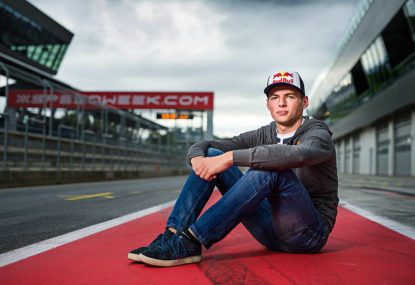'Welcome back': Reliving the last Chinese Grand Prix ahead of its much-anticipated return five years later
Five-years is a long time in motorsport, let alone the general state of the world – especially given the impact of the Covid-19 pandemic…

After the British Grand Prix hype wound down and the British public had had enough time to think to themselves, “Yes, I will wash those hands that supported Lewis Hamilton’s crowd-surfing”, Silverstone welcomed Formula One back to its hallowed circuit for the second in-season test of the year.
With the exception of Sauber, which didn’t attend on cost grounds, every team featured a young driver on at least one of the test’s two days, as stipulated by the rules.
Some of the names were familiar for having spent significant time hovering by the Formula One door, with Mercedes running Esteban Ocon; Red Bull Racing, Pierre Gasly; Williams, Alex Lynn; McLaren, Stoffel Vandoorne; Renault, Sergey Sirotkin; and Manor, Jordan King.
Others would have been less familiar to those not following the junior categories, including Charles Leclerc at Ferrari, Sergio Sette Camara at Toro Rosso, Nikita Mazepin at Force India, and Santino Ferrucci at Haas.
While some on this list of rising stars still have time to go until they’re ready to fill a Formula One seat, many of them could mount comprehensive arguments as to why they deserve a chance sooner rather than later.
Stoffel Vandoorne is the highest profile among them, teetering as he is on the brink of a drive with McLaren, depending on the team’s decision to retain or drop Jenson Button. If it keeps the 2009 world champion, Vandoorne may attempt to forge his own deal for one of the scarce few seats available for 2017.
Esteban Ocon is also of Formula One maturity, and he too is tipped for a 2017 drive. It will most likely be with Renault as a replacement for either Kevin Magnussen or Jolyon Palmer – or both, if Toro Rosso loans Carlos Sainz to Renault in exchange for 2017 power units and to make space for Pierre Gasly.
Alex Lynn is on Formula One’s radar, but only just. A winner of the Macau Grand Prix and the 2014 GP2 champion, Lynn is Williams’s development driver, but his name is rarely mentioned in the team’s driver permutations for next season.
Sergey Sirotkin is another to have flirted with an Formula One future, briefly winning one of Sauber’s 2014 race seats in a deal that never materialised.
In a year or two Charles Leclerc will be knocking on the door, he is a teenager and Ferrari young driver rated as highly as Jules Bianchi and Max Verstappen. As will Jordan King and Red Bull junior Sergio Sette Camara, not to mention the three others younger Red Bull-backed drivers impressing in the lower divisions.
The future would be bright but for the glaringly obvious problem: where do we put them?
Formula One comprises only 22 seats, notionally occupied by the best 22 drivers in the world. It should never be easy to make it to Formula One, but with the increasingly professionalised world of the junior single-seat categories, a bottleneck has emerged between Formula One and everything else.
Generations of talent are at risk of being lost to the sport – indeed, generations have already disappeared.
Robin Frijns was Max Verstappen before Max Verstappen turned up, but nothing came of his development deals with Sauber or Caterham. He now races in the GT Series.
Alexander Rossi continues to keep his foot wedged in the closing Formula One door as a reserve driver after his fleeting five-race deal with Manor last season came to nought. This year he won the Indianapolis 500.
Sam Bird was an LMP2 champion in 2015 after his test driver deal with Mercedes couldn’t open doors for him and Fabio Leimer’s 2013 GP2 championship amounted to nothing in the Formula One sphere.
Also consider Davide Valsecchi, *the* next Italian Formula One driver: when Kimi Räikkönen bailed early on Lotus at the end of 2013 the 2012 GP2 champion was overlooked for Heikki Kovalainen. He’s now one of Sky Sports Italia’s Formula One presenters.
Meanwhile, Kimi Räikkönen has been re-signed for at least one more season despite scoring 58 per cent of his teammates’ points since joining Ferrari in 2014.
A merit-based contract system could present a solution. If you’re a driver with more than three years of experience and can’t score 60 per cent of your teammate’s points total – and that’s a fairly generous threshold in the cut-throat world of Formula One – your contract is terminated, forcing you to re-negotiate terms among a number of talented, hungry, and cheap young drivers.
To grease the conveyer belt of Formula One’s feeder series, Formula One’s commercial rights holder, which also owns GP2, ought to put up prize money on behalf of the year’s GP2 champion to boost his bid for one of the vacated seats, thereby fulfilling the category’s aim.
It wouldn’t guarantee perpetual driver change – a driver who had been heavily outscored due to poor reliability could still be re-signed by a team – but it would give new drivers a better chance of making it to the top of the motorsport tree.
It isn’t a perfect solution, but Formula One puts its claim to hosting 22 of the world’s best drivers at risk if it allows the future of motorsport to pass it by.
How would you help to promote young talent into Formula One? Leave a comment below.
Follow @MichaelLamonato on Twitter